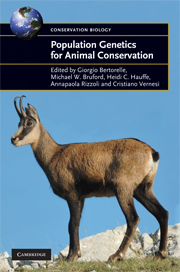Book contents
- Frontmatter
- Epigraph
- Contents
- List of contributors
- Foreword
- Acknowledgements
- 1 Introduction
- Statistical approaches, data analysis and inference
- Molecular approaches and applications
- From genetic data to practical management: issues and case studies
- 10 Future-proofing genetic units for conservation: time's up for subspecies as the debate gets out of neutral!
- 11 Genetic diversity and fitness-related traits in endangered salmonids
- 12 Genetics and conservation on islands: the Galaápagos giant tortoise as a case study
- 13 Evolution of population genetic structure in marine mammal species
- Future directions in conservation genetics
- Software index
- Species index (common name)
- Species index (Latin name)
- Subject index
13 - Evolution of population genetic structure in marine mammal species
from From genetic data to practical management: issues and case studies
Published online by Cambridge University Press: 05 July 2015
- Frontmatter
- Epigraph
- Contents
- List of contributors
- Foreword
- Acknowledgements
- 1 Introduction
- Statistical approaches, data analysis and inference
- Molecular approaches and applications
- From genetic data to practical management: issues and case studies
- 10 Future-proofing genetic units for conservation: time's up for subspecies as the debate gets out of neutral!
- 11 Genetic diversity and fitness-related traits in endangered salmonids
- 12 Genetics and conservation on islands: the Galaápagos giant tortoise as a case study
- 13 Evolution of population genetic structure in marine mammal species
- Future directions in conservation genetics
- Software index
- Species index (common name)
- Species index (Latin name)
- Subject index
Summary
INTRODUCTION
Marine mammals are a taxonomically diverse group of species with evolutionary roots right back to the earliest mammalian radiations. The smallest species is a mustelid, the sea otter (Enhydra lutris), and the largest the blue whale (Balaenoptera musculus). The only things marine mammals have in common are the facts that they are all mammals (and therefore dependent on breathing air and constrained by the necessities of live birth and maternal care), and they are all dependent on an aquatic, typically marine environment. These two common attributes have meant that they are constrained in similar ways, though the different groups have met these challenges in different ways. The mustelid, the carnivore (polar bear, Ursus maritimus) and the pinnipeds (seals, sea lions and walrus) all meet thermoregulatory challenges with dense pelage. Most of these also still give birth on land, and are to varying extents amphibious. The cetaceans (whales, dolphins and porpoises) and sirenians (manatees and dugongs) are fully aquatic, and have little or no pelage. Instead they have adjusted to the high thermal conductivity of water and the generally cold temperatures by developing thick layers of subcutaneous fat, and in many cases, by becoming large (which provides a high volume to surface area ratio and conserves heat). All of these species, with the exception of the polar bear, have adapted to more efficient locomotion in water by acquiring a relatively fusiform shape – most extensively developed in the delphinid cetaceans (the dolphins).
In this chapter my focus will be on those features among the marine mammals that help to explain common patterns of population structure, or differences in these patterns among taxa. One feature shared by many is their high trophic position in the ecosystems they occupy. One exception is the sirenians, which are herbivorous. However, most marine mammals are predators, though their trophic position can vary dramatically (from baleen whales feeding on krill to killer whales feeding on other marine mammals). Another typical feature is large size.
- Type
- Chapter
- Information
- Population Genetics for Animal Conservation , pp. 294 - 318Publisher: Cambridge University PressPrint publication year: 2009
- 21
- Cited by



